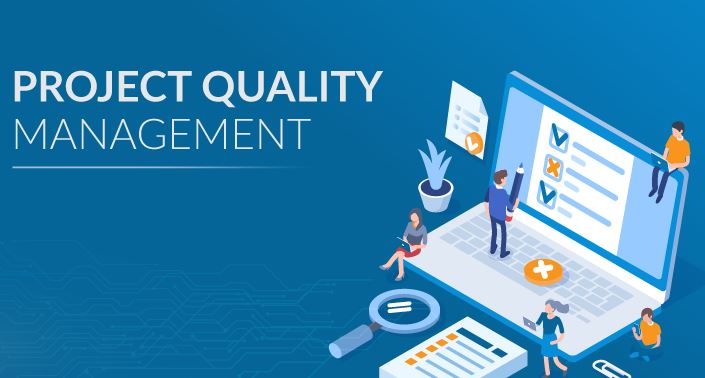
Project Quality Management Summary 6th Edition
27 June 2020Project Quality Management Summary 6th Edition
- Quality as a delivered performance or result is the degree to which a set of inherent characteristics fulfill requirements.
- Grade as a design intent is a category assigned to deliverables having the same functional use but different technical characteristics.
- Prevention (keeping errors out of the process) and inspection (keeping errors out of the hands of the customer).
- Failure costs also called cost of poor quality and they can be internal (found by the team) and external (found by the customer).
- Effective quality management can be done in five ways:
✓ Let the customer find defects.
✓ Detect them before product sent to customer.
✓ Use quality assurance to examine.
✓ Incorporate quality into the planning and designing of the project and product.
✓ Create a culture at organization.
- Continual improvement: The plan-do-check-act (PDCA) cycle is the basis for quality improvement as defined by Shewhart and modified by Deming. Also, TQM, Six Sigma and Lean Six Sigma can improve project and product quality.
- Data Gathering:
✓ Benchmarking: comparing actual or planned project practices or the project’s quality standards to those of comparable projects (Internal or external) to identify best practices & generate ideas for improvement.
✓ Brainstorming: gather data creatively from a group of team members or subject matter experts.
- Data Analysis:
✓ Cost-benefit analysis: Financial analysis tool used to estimate the strengths and weaknesses of alternatives in order to determine the best alternative in terms of benefits provided. It will help Project manager to
determine if the planned quality is cost effective.
✓ Cost of Quality (COQ): consists one or more of the following costs >>
Cost of Conformance
❖ Prevention costs: (Training, Document process, Equipment and Time to do the right).
❖ Appraisal costs: (Testing, Destructive testing loss and Inspection).
Cost of Nonconformance
❖ Internal Failure costs: (Rework & Scrap).
❖ External Failure costs: (Liabilities, Warranty work & Lost business).
- Data Representation:
✓ Flow Charts (process maps):
❖ Display the sequence of steps and the branching possibilities that exist for a process that transforms one or more inputs into one or more outputs.
❖ It shows activities, decision points, loops, parallel paths, and the overall order of processing by mapping the operational details of procedures that exist within a horizontal value chain. One version of value chain is called SIPOC (suppliers, inputs, process, outputs and customers) model.
❖ Flowcharts are useful in understanding and estimating the cost of quality for a process.
❖ They can be called (process flows or process flow diagrams) when they used to represent the steps in a process. Which is used for process improvement and identify quality defects .
✓ Logical data model:
❖ Visual representation of an organization’s data, described in business language and independent of any specific technology. Can be used to identify where data integrity or other quality issues can arise.
✓ Matrix diagrams:
❖ Help find the strength of relationships among different factors.
✓ Mind mapping:
❖ The mind-mapping technique may help in the rapid gathering of project quality requirements, constraints and relationships.
- Test and Inspection planning: During planning phase, the project manager and the team determine how to test/inspect the product to meet the stakeholders’ expectations and meet product’s performance and reliability goal.
- Quality Management Plan: Describes the activities and resources necessary for the project management team to achieve the quality objectives set for the project.
- Quality Metrics: Describes a project or product attribute and how the Control Quality process will verify compliance to it. Examples (percentage of completed tasks, failure rate, defects number and errors found).
- Manage Quality is sometimes called quality assurance. although Manage Quality has a broader definition than quality assurance as it is used in non-project work.
- Quality assurance focuses on the processes used in the project and using these processes effectively by follow and meeting standards.
- Manage quality includes all the quality assurance activities and also concerned with the product design aspects and process improvements.
- Manage Quality is considered the work of everybody. In agile projects quality management is performed by all team members. However, in traditional projects only specific members does it.
- Checklists: structured tool, usually component-specific, used to verify that a set of required steps has been performed or to check if a list of requirements has been satisfied.
Quality checklists should incorporate with scope baseline. Usually developed based on historical information.
- Data Analysis:
✓ Document analysis: analysis of different documents produced as part of the output of project control processes.
✓ Process analysis: identifies opportunities for process improvements also examines problems, constraints, and non-value-added activities that occur during a process.
✓ Root cause analysis (RCA): analytical technique used to determine the basic underlying reason that causes a variance, defect, or risk. It may underlie more than one variance and it may also use to solve these root causes.
- Data Representation:
✓ Affinity diagrams: organize potential causes of defects into groups.
✓ Cause-and-effect diagrams: (known as fishbone diagrams, why-why diagrams, or Ishikawa diagrams). These diagrams break down the causes of the problem, helping to identify the main or root cause of the problem.
✓ Flowcharts: show a series of steps that lead to a defect.
✓ Histograms: graphical representation of numerical data. Histograms can show the number of defects per deliverable, a ranking of the cause of defects, the number of times each process is noncompliant or other
representations of project or product defects .
✓ Matrix diagrams: show the strength of relationships among factors, causes, and objectives that exist between the rows and columns that form the matrix.
✓ Scatter diagrams: graph that shows the relationship between two variables.
- Audits :
✓ Structured, independent process used to determine if project activities comply with organizational and project policies, processes, and procedures .
✓ Usually conducted by a team external to the project such as (organization’s internal audit department, PMO or an external auditor to the organization).
✓ The subsequent effort to correct any deficiencies should result in a reduced cost of quality and an increase in sponsor or customer acceptance of the product.
✓ Quality audits may be conducted by internal or external auditors.
- Design for X (DfX):
✓ Technical guidelines that may be applied during the design of a product for the optimization of a specific aspect of the design.
✓ DfX can control or even improve the product’s final characteristics .
✓ DfX result in cost reduction, quality improvement, better performance, and customer satisfaction.
- Problem Solving:
✓ Finding solutions for issues or challenges.
✓ Effective and systematic problem solving is a fundamental element in quality assurance and quality improvement.
✓ Problems can arise as a result of the Control Quality process or from quality audits and can be associated with a process or deliverable.
- Quality Reports:
✓ Reports can be graphical, numerical, or qualitative.
✓ Reports information can be used by other processes to take corrective actions to achieve quality expectations
✓ Reports may include all quality management issues escalated by the team; recommendations for process, project, and product improvements; corrective actions recommendations the summary of findings from the Control Quality process.
- Test and Evaluation Documents:
✓ Inputs to the Control Quality process and are used to evaluate the achievement of quality objectives.
✓ They may include dedicated checklists and detailed requirements traceability matrices.
✓ They can be created based on industry needs and the organization’s templates.
- Control quality in agile projects can be performed by all team members throughout the project life cycle. However, in waterfall projects it’s performed at specific times, toward the end of the project or phase, by specified team members.
- Deliverables that are outputs from the Direct and Manage Project Work process are inspected and compared to the acceptance criteria defined in the project scope statement.
- Data Gathering:
✓ Check sheets (Tally sheets): organize facts in a manner that will facilitate the effective collection of useful data about a potential quality problem.
They are especially useful for gathering attributes data while performing inspections to identify defects.
✓ Statistical sampling: involves choosing part of a population of interest for inspection. The sample is taken to measure controls and verify quality. Sample frequency and sizes should be determined during the Plan Quality Management process.
✓ Questionnaires and Surveys: gather data about customer satisfaction after the deployment of the product or service. The cost regarding defects identified in the surveys may be considered external failure costs in the COQ model and can have extensive cost implications for the organization .
- Performance reviews: measure, compare, and analyze the quality metrics defined by the Plan Quality Management process against the actual results.
- Inspection:
✓ Determine if the product conforms to documented standards .
✓ They can be done on single activity or at final product.
✓ Inspection can be called reviews, peer reviews, audits, or walkthroughs.
✓ Inspections also are used to verify defect repairs.
- Control charts:
✓ Determine whether or not a process is stable or has predictable performance.
✓ Upper and lower specification limits are based on the requirements and reflect the maximum and minimum values allowed.
✓ Upper and lower control limits are different from specification limits .
✓ The control limits are determined using standard statistical calculations and principles to ultimately establish the natural capability for a stable process .
✓ Project manager and appropriate stakeholder use controlled control limits which corrective action will be taken to prevent performance that remains outside control limits.
✓ Control charts can be used to monitor various types of output variables to help determine if the project management process is in control.
✓ The sample out of control if there are 7 values either above or below the mean. Or if there is any value outside the control limits .
- Quality Control Measurements:
✓ Documented results of Control Quality activities. They should be captured in the format that was specified in the quality management plan.
- Verified Deliverables:
✓ The results of performing the Control Quality process are verified deliverables that become an input to the Validate Scope process for formalized acceptance.
✓ If there were any change requests or improvements related to the deliverables, they may be changed, inspected, and reverified.
- Important Notes:
✓ Processes and quality plan>>>>Manage quality.
✓ Deliverable>>>> Control quality.
✓ Defect repair>>>> weak performance is in product under operational conditions which means quality problem is in product will require.
✓ Prevention action>>>> New changes to ensure the future performance will change.


